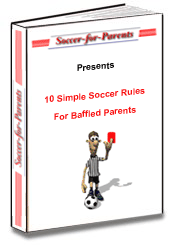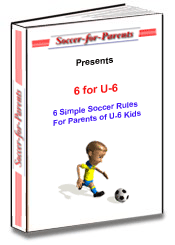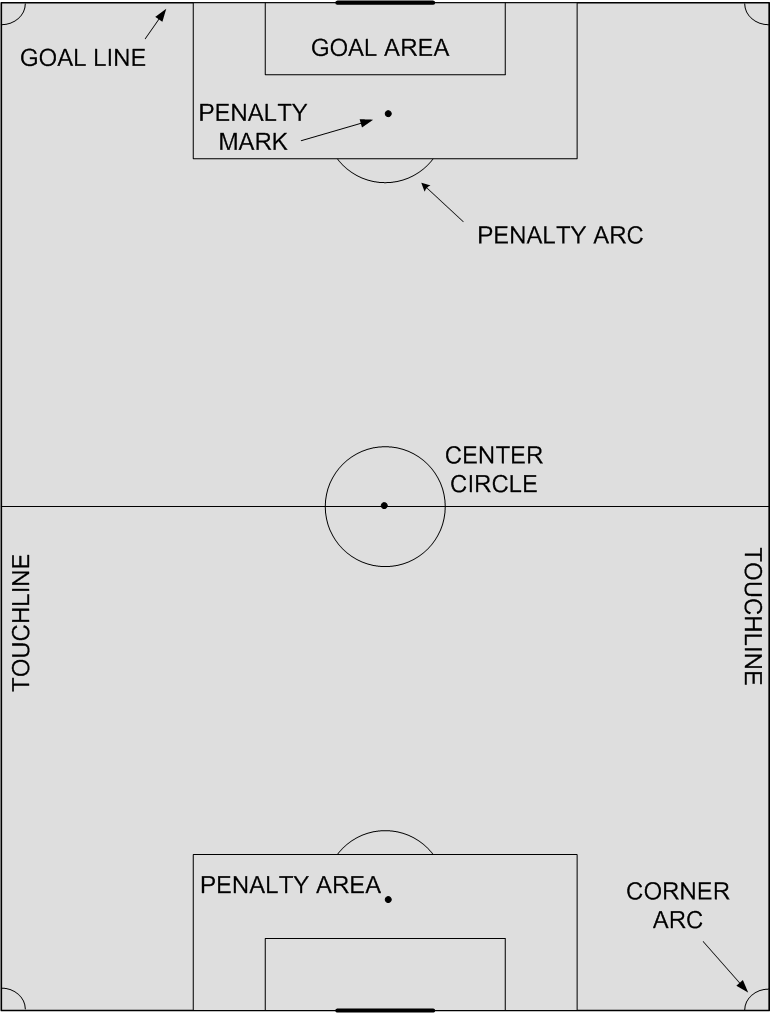The Easy Guide to
Soccer Rules
It sure would be nice to know the soccer rules.
Have you ever said that? I haven’t either.
Seriously though, most parents in the US have never played the game and don’t know much about the rules of soccer – kind of like trying to watch hockey in Alabama.
Exclusively from
Soccer-for-Parents!!
Version 2 just released!
Just what you've been looking for! The basic soccer rules have been explained in a simple manner for parents and coaches alike! Download the book, print it out, and use it at your next coaches or parents meeting!
FREE Soccer Rule Book v2.0
(331kb
pdf)
Simplified Rules (6) for U6!
Just released is a new version geared towards the U-6 age group and their
parents. Great as a handout, download
it now!
U-6 Soccer Rule Book
v1.0
(185kb pdf)
What I have tried to do below is explain the main rules of soccer that you need to know as a parent.
If you want the official version, feel free to surf on over to the FIFA website. This FIFA page has the official FIFA Laws of the Game 2012/13 . The soccer rules are in pdf format and easy to print out, although it gets a little bulky. I did it myself before getting certified as a referee for the first time.
Last, but certainly not least is a new interactive Flash guide to Offside Law 11 courtesy of FIFA.
Also, please bear in mind that the US Youth Soccer Association (USYSA) issues
their own “official” modified FIFA soccer rules for players under the age of 12.
These modified rules are essentially guidelines for the appropriate number of
players, field size, and ball size for different age levels. Here are links to
them.
Official Modified Under 6 Playing Rules
Official Modified Under 8 Playing Rules
Official Modified Under 10 Playing Rules
Official Modified Under 12 Playing Rules
|
Local and state soccer organizations are strongly encouraged to adopt the soccer rules from the USYSA but as far as I know they are not mandated. Each local youth organization can ultimately do whatever they feel is best for the kids in their area. Also for reference here is a soccer field diagram to use when reading the rules below. You can either right click, save it, and open in a separate window, or just click the diagram below to open on another browser tab (hopefully, depends on your settings). |
OK. On with the show.
Here’s the short and simple soccer rules you need to know as a parent.
1. No Hands, please
I bet you knew that one. Most people who know nothing about soccer still know that you aren’t supposed to use your hands unless you’re the goalie.
A couple of points to clarify.
First, the rule for a hand ball includes using any part of the body from the tips of the fingers to the shoulder.
Second, the proper way to look at this soccer rule is that a player cannot “handle” the ball. A ball that is kicked and hits a player’s hand or arm is not a hand ball. This means that the referee must use his or her own judgment to some extent in determining whether or not a hand ball is accidental contact or a purposeful attempt to gain an advantage.
Believe it or not, there is also a situation in which the goalie cannot use his/her hands. This is sometimes called the back-pass rule. Goalkeepers cannot pick up a pass that came directly from one of their teammates. In this case, the goalkeeper must use his feet. Infraction of this soccer rule will result in an indirect kick from the point of the infraction.
2. Throw-ins
A throw-in is taken when the ball crosses a sideline and leaves the field. The two basic soccer rules for a proper throw-in are to have both feet on the ground and to throw the ball with both hands over the head.
For teaching purposes it is common to allow players under the age of 8 to take more than 1 attempt.
3. Corner Kicks & Goal Kicks
A corner kick or goal kick is taken when the ball leaves the field across the endline – you know, the end of the field.
If the offensive team kicks it out, play is restarted with a goal kick. If the defensive team kicks it out, play is restarted with a corner kick.
The goal kick is taken from anywhere inside the “goalie box” as it is affectionately called. It can be taken by any player, not just the goalkeeper.
The corner kick is taken from – yes, you guessed it – the corner nearest to where the ball left the field.
You may be confused at times in youth soccer games to see a goal kick retaken. This is because the FIFA soccer rules state that the ball is not back “in play” until it leaves the penalty area, the large box outside of the “goalie box”. No one can touch the ball until it leaves the penalty area, and if the ball is not kicked properly to leave the area, the kick must be retaken.
4. Fouls
The common rule of thumb on fouls is “If it looks like a foul, it probably is.”
Too true. A player cannot kick, trip, jump at, charge, strike, push, hold, or spit at an opponent.
So what’s the problem?
Soccer can be a physical, contact sport when two opposing players both want the soccer ball and no parent likes it when little Johnny loses the ball and ends up on the ground!
“Foul!” cries the parent. “Little Johnny was pushed!”
What you need to know as a parent is that bumping or going shoulder-to-shoulder while competing for a ball is not a foul until the hands or elbows come up. This is a bit of a judgment call and not all referees will call it the same way. Some soccer rules are actually not black-and-white.
Remember though, the referee is ALWAYS right.
5. Direct and Indirect Free Kicks
The simple difference between the two is this: On a direct kick you can score by kicking the ball directly into the goal. On an indirect kick you cannot score. An indirect kick must be touched by another player before it can go into the goal – that is the kicker and a second person.
As a parent on the sideline, you can tell whether the kick is direct or indirect by looking at the referee. For an indirect kick, the referee will hold one arm straight up in the air until the second person touches the ball. No arm up, it’s a direct kick.
There are many soccer rules around what causes a direct or indirect kick.
In general, a direct kick comes from a contact foul or hand ball. Everything else is indirect.
6. Penalty Kick
A penalty kick results from a contact foul or hand ball by the defending team within the penalty area – the large box on either end of the field. So it’s a type of direct kick also.
The ball is placed on the penalty spot, 12 yards in front of the center of the goal.
All players must remain outside the penalty area and the penalty arc until the ball is kicked. The goalkeeper must have both feet on the goal line until the ball is kicked.
If after the ball is kicked, it rebounds off of the goal or the keeper and stays on the field, the ball is “live” and anyone can play it.
7. Two-touch Rule
A player cannot touch the ball twice in a row when putting the ball in play. You will see this called many times in youth soccer. It applies everywhere. You will see it frequently on kick-offs or direct and indirect kicks. If a kid barely hits the ball and decides to take another swipe at it, that is a two-touch.
This also applies to throw-ins. A kid cannot throw the ball in and then kick it. Nope. No way. No can do.
8. Yellow and Red Cards
This is the way punishment is given in soccer. The FIFA soccer rules give the guidelines for when to give a yellow card to a player and when to give a red card. I’m not going to get into the specifics here.
If a player is given two yellow cards in the same game, that is equal to a red card. A red card can be given at any time without the player first receiving a yellow card. When a player gets a red card, they must leave the game and their team must play short. An ejected player cannot be replaced.
9. Offside
I decided to leave the best for last.
This is without a doubt the least understood rule by parents and coaches alike.
Check your local league soccer rules first. There’s a good chance that this rule won’t be called for the U8 or younger teams. You may be off the hook for now. However, if you are a U8 or U6 coach you still need to know this rule so you can begin teaching your players not to be offside.
The first thing to know is that you cannot be offside on a corner kick, goal kick, or throw-in. Don’t ask me why. Just accept it and go on. The explanation is too long.
Also, it is not an offense for a player to be in an offside position. The player must be involved in active play as determined by the referee to be called offside.
As quoted from the FIFA soccer rules:
A player is in an offside position if: he is nearer to his opponents’ goal line than both the ball and the second last opponent.
Clear yet? I didn’t think so.
Try this. An offensive or attacking player can’t be ahead of the ball and involved in the play unless there is a defender between him and the goalkeeper. Or, you can’t hang out at the other team’s goal waiting for the ball.
A few other buts. You can’t be offside if you are standing on your half of the field. Also, the offside rule applies when the ball is kicked, not when the player receives the ball.
To be honest with you, this can be a hard rule to understand. Don’t get too hung up on it. Trust the referees. Download the FIFA Laws of the Game . They have good diagrams of what is and isn’t considered offside.
If you really want to learn the offside rule, either attend a referee clinic or buy a video on soccer rules . The video will show you several examples of real situations and will logically detail why they were either offside or not offside. It would be a great idea for your local league to purchase one and show parts of it at a coaches’ meeting or clinic. The more people that understand soccer rules the better.
Soccer-for-Parents › › Soccer Rules
Like this page?

NEW!
Soccer-for-Parents is excited to now offer our Simple Soccer Rules to parents "on the go". This is our own free android app (sorry ipeople) that installs in seconds and contains everything on our normal rules page along with a link to the official FIFA rules and USYSAA rules. Here is the free app!
(ad free version here)








New! Comments
Have your say about what you just read! Leave me a comment in the box below.